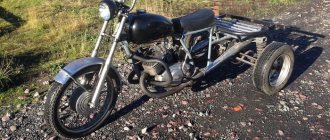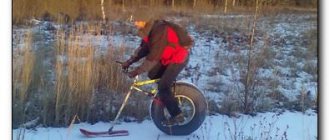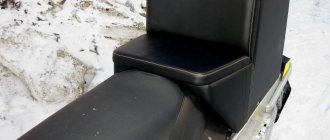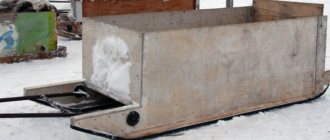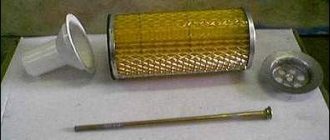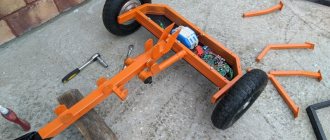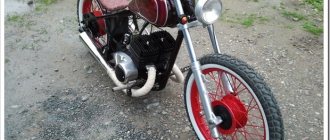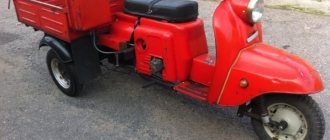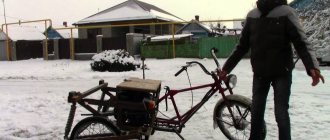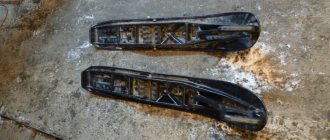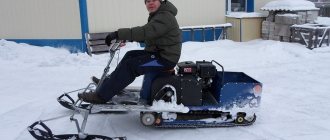Crawler snowmobile from a walk-behind tractor: the manufacturing process at home
The snowmobile, the picture of which is presented below, is based on the motor of the Neva cultivator. Its production begins with the frame.
DIY snowmobile frame
The frame is made of metal pipes with a diameter that is used for motorcycle frames. Water pipes are also suitable. A pipe bender is used to give the desired shape.
To simplify the task and reduce design time, we suggest using ready-made drawings. Designations according to the drawing:
- frame;
- intermediate type shaft sprocket;
- intermediate shaft;
- sprocket with teeth;
- gear parts;
- track drive elements;
- track shaft;
- ski support stands;
- tensioner rollers for tracks;
- axis for tensioning rollers;
- towbar;
- tensioner;
- drum flanges;
- steering column
After welding the frame elements to the established dimensions, a subframe is made in its front part - the motor is localized on it. To do this, a stand with holes for it is welded. The same holes should be in the traverse itself. Through these slots it will be convenient to tension the drive chain and adjust the position of the traction unit.
In order to ensure that the device can be started with a handle, the underframe frame is moved to the rear of the unit. Equipping the original walk-behind tractor with a forced cooling function will be an invaluable bonus. This will reduce wear on the carburetor and traction mechanism.
Intermediate shaft for a snowmobile made from a walk-behind tractor
The diagram shows a general view of the intermediate shaft. The numbers in the figure indicate:
- support part for the operator's seat;
- cross member - made of stainless pipe 28 x 28;
- rack axle - made of pipes 18 x 18;
- traverse - from a metal corner with a side of at least 25 mm;
- jib - a steel billet 0.4 x 0.05 m is taken as it;
- bearings No. 204;
- shaft (pipe based);
- toothed sprocket (like element 10);
- spar;
- rubber casing.
All these details can be made with your own hands.
Making a steering column for a snowmobile: basic drawing with dimensions
A properly assembled and adjusted steering column is a prerequisite for a snowmobile made from a walk-behind tractor to be able to navigate through deep snow and to easily overcome uneven terrain.
According to our proposed scheme, the steering block is formed by:
- frame traverse;
- steel stand in pipe design;
- corner steering support;
- a shaft made of stainless steel pipe;
- crossbar;
- bipod;
- bronze washer;
- sleeve;
- nut type M10.
After connecting them, we move on to the tracked part of the snowmobile.
Tracks for a snowmobile based on a walk-behind tractor
The tracked snowmobile attachment is made by hand using one of the proposed options:
- conveyor belt;
- water pipes;
- motorcycle chains.
For a light snowmobile, you can limit yourself to a conventional conveyor belt, to which a roller chain is adapted.
For more serious homemade products, it is better to make caterpillar tracks from slats in quantities of at least 30 pieces with a distance between adjacent ones of 3.8 cm. The recommended size of the tracks according to the drawing is 50 x 3.8 x 1.8 cm. It is advisable to acquire a template-slipway so that prevent curvature and discrepancies in values.
According to the picture:
- nut ties;
- star element;
- track drive;
- tensioner;
- ice rink;
- rack and pinion track;
- homemade spar;
- driven mechanism;
- ski;
- ski harness;
- bolt, like 12 and 13;
- guide;
- screw;
- support shoe;
- bearing fasteners;
- roller axle.
Don't forget about the front skis. They are reinforced with side members, additional springs and equipped with a lever for pulling out the snowmobile if it gets stuck.
After the base blocks are prepared, we move on to the assembly stage.
Caterpillar for UAZ
Next we will tell you how to make tracks on an UAZ with your own hands. For this model, a caterpillar made from ordinary car tires is suitable. Select a massive truck tire in advance.
Be sure to pay attention to the characteristic tread pattern. If it has triangular cutouts, then the tire will fit.
To make it, you need to carefully cut out the sides and, most importantly, do not forget to leave space for the treadmill. Then start connecting the resulting tires using car belts.
The result of the work will be a ready-made caterpillar for operation by the UAZ all-terrain vehicle.
Other creation options
There are other ways to build a snowmobile using skis or a crawler rear. These makeshift snowmobiles and snowbikes use bicycle wheels.
Snowmobile from scooter
One of the simplest homemade options you can create yourself from any scooter or moped. The only differences here are the frames, the sizes of the tracks, and other parts. Such a snowmobile is unlikely to be powerful and will have difficulty moving through snow-covered snowdrifts. Therefore, they use wheels of a smaller diameter and increase the frame. This homemade moped moves well on light snow or crust. In the spring, you can replace the ski or track back with wheels and get a scooter or moped again.
Chainsaw snowmobile
Using a motor from a trimmer, many craftsmen can independently make various devices: cultivators, motorbikes, snowblowers and, of course, snow scooters (or snowmobiles).
Important KamAZ-65225 6x6: review of an all-terrain tractor
The product is not particularly powerful, but reliable, lightweight and easy to use.
Snowmobile from a motorized dog
It is even easier to get a snowmobile from a motorized towing vehicle or a motorized dog; there is practically no need to reassemble it - just add skis with steering and make minor changes.
Snowmobile from ATV
The ATV undergoes even less alteration for better maneuverability in winter snowy terrain. Essentially, everything is limited to tuning, which consists of installing tracks, although this process is expensive and time-consuming.
Snowmobile on tubes
About homemade products using cameras or pneumatics has already been noted above. The homemade device consists of a control support ski and a leading support pneumatic.
The advantages include the high cross-country ability of the vehicle, and the disadvantages include low maneuverability.
Transformable snowmobile
A folding snowmobile is called a mini snowmobile or transformer. Its main difference is convenience and ease of use. It easily fits when folded in the trunk or even on the seat of a car.
Snowmobile from a cultivator
And another savvy option for inventive use - a snowmobile made from a cultivator. Usually, every farm has a cultivator and sits idle in the winter. Using the engine according to the assembly diagram, we make an apparatus for winter movement. The power is small, but in reality it is practical and effective.
General rules of constructions
Self-made snowmobiles are often completely different. But they are all united by the desire to give the snowmobile the following properties:
- do not fall into the snow;
- move in the right direction and at the right speed.
In order for a snowmobile to satisfy these conditions, its design must contain several mandatory elements:
- supports (wheels, tracks, runners);
- engine;
- steering wheel that changes the direction of the snowmobile;
- frame.
When making a homemade snowmobile, you can use a wide variety of elements and parts from other devices, which greatly simplifies the process.
Simple children's snowmobiles
If you want to make a snowmobile for a child, then you should not use a powerful engine. Homemade products must be created in accordance with the age, weight and height of the child.
It’s worth starting with the support - installing the skis under the frame. To make the process easier, you can use a snow scooter. Then you should install a motor with low power (about 2 horsepower). It can be removed from a chainsaw.
If you are planning a children's snowmobile, then there is no need to further strengthen the frame, but for transporting adults this procedure is required.
Ice motor sleigh
Movement in winter, especially on ice, is very difficult. Therefore, many fishermen who do not have the budget to purchase expensive equipment are thinking about making ice snowmobiles themselves.
Unlike a children's snowmobile, an adult's snowmobile uses a sled instead of a snowmobile.
Next, attach a chainsaw motor with a power of 4-5 horsepower (you can use a “Friendship” chainsaw). This design is well suited for icy surfaces, but is not suitable for moving on snow (especially loose snow).
Inflatable wheels
You can also make a snowmobile on inflatable wheels. To do this, take rims from a motorcycle or bicycle and wide inflatable chambers from the wheels of a truck or tractor. Chains or crossbars are attached around their circumference to increase traction. To give the cameras strength, liquid rubber should be applied to their surface or some kind of waterproof material should be glued. For such snowmobiles, you can take frames with engines from motorcycles (Ural or Dnepr).
On caterpillar tracks
Homemade snowmobiles on tracks have high speed and reliability, which is why they are popular.
Tracks can be made in several ways, for example, from truck tires or from conveyor belts.
Plastic tubes less than an inch in diameter, cut lengthwise, are screwed across the tape. Conveyor belt tracks can be reinforced with a chain.
If you cut the sidewalls from truck tires with winter tread, they can also be used as tracks. To do this, you need to sweep the edges with fishing line in centimeter increments.
Upgrading homemade snowmobiles
After using a homemade snowmobile for the first time, people notice some shortcomings that they want to correct.
To begin with, it is worth making it possible to use a snowmobile not only in the daytime, but also in the dark. You will need a lamp and a generator (you can take a bicycle one).
To prevent the wind from sweeping snow into your eyes, you can install ready-made windshields on your homemade vehicle or come up with something of your own.
How to make a homemade snowmobile from a walk-behind tractor on tracks
Four wheels are installed inside the track. When movement occurs, they roll along a conveyor belt with fixed lugs. The caterpillar drive is carried out by a chain from the motor, special drive sprockets, through the driven shaft. They were taken from Buran.
The engine is taken from a conventional walk-behind tractor with a power of 6 hp. You won't be able to accelerate quickly on it. The soft ski and track suspension have been removed because the sled is designed to ride on powder. This simplified the design and reduced the weight of the snowmobile.
Making tracks for a snowmobile
Let's look at the process of making a caterpillar. Plastic water pipe 40 mm, cut to length 470 mm. Blanks for lugs will be made from them. After which each of them is sawn lengthwise into equal parts with a circular saw.
The lugs are attached with furniture bolts to the conveyor belt
When making a track, it is extremely important to maintain the same distance between the lugs. Otherwise, there will be a “running” on the teeth of the drive sprocket, as a result of which the caterpillar will slip and slide off the rollers
To drill holes for the mounting bolts in the conveyor belt, a jig was made. To drill the holes, a wood drill with a special sharpening was used.
This jig allows six holes to be drilled simultaneously into the conveyor belt to attach three track lugs. Drive sprockets (2 pcs), an inflatable rubber wheel (4 pcs), sealed bearings No. 205 (2 pcs) were also purchased.
The turner made a support for the bearings and the drive shaft of the track. The snowmobile frame is made independently. For this, square pipes 25x25 mm were used. The articulated axes of rotation of the steering wheel and skis are in the same plane and on the same line, so a continuous steering rod without ball ends was used.
Ski turning bushings are quite easy to make. A plumbing coupling with a 3/4-inch internal thread is welded onto the front cross member of the frame. The pipes with external threads are screwed in there. I welded the bipod of the ski rack and steering rod to them. Angles are installed on the skis, which serve as an attachment to the snowmobile's rotating stand. A metal undercut is made at the bottom to better control the snowmobile while driving on compacted snow or crust.
Chain tension is adjusted by motor offset
Driving a snowmobile is quite simple. To increase engine speed, use the gas handle, which is located on the steering wheel. This engages the automatic centrifugal clutch, causing the snowmobile to move. Since the engine power is low, the speed of the snowmobile is 10-15 km/h. Therefore, brakes are not provided. To stop you need to reduce the engine speed.
Tracks are manufactured in any width. Choose what is more convenient to make: a narrow but long track, or a wide but short one
It is important to remember that a larger track will put more strain on the engine and make the snowmobile more difficult to control. If the caterpillar is made small, the car may fall through in deep snow
The weight of the snowmobile with all parts was 76 kg. It included: steering wheel and engine (25 kg), skis (5 kg), wheels with axles (9 kg), drive shaft (7 kg), caterpillar (9 kg), seat with racks (6 kg).
Important Japanese mini tractor manufacturer Yanmar
You can reduce the weight of some parts. For this size of a snowmobile with a caterpillar, the weight indicator is quite satisfactory.
Advantages of a homemade snowmobile from a walk-behind tractor
Externally, a homemade car is less attractive compared to a factory-made analogue. However, there are many positive aspects to be found. One of the advantages is the fact that the snowmobile is customized. That is, the owner clearly knows what he wants: to transport cargo, go fishing, to the forest, and do other things.
Externally, the homemade product is not attractive, but it meets all the owner’s requirements
Other advantages include the following:
- Buying a walk-behind tractor and a snowmobile for your farm is expensive. You will need space to store two cars, and each of them will be idle during the off-season. It’s cheaper to get one walk-behind tractor. Use it in winter instead of a snowmobile, and in summer for its intended purpose.
- A homemade design will not require large expenses. Many spare parts are suitable for used cars. At scrap metal you can cheaply buy scraps of pipes, channels and other metal.
- The snowmobile can be used even in summer. The tracked vehicle has good cross-country ability in mud.
Homemade products are a big plus for craftsmen who are accustomed to doing everything with their own hands. A person who shows interest in technology constantly improves it and comes up with new devices.
DIY snowmobile
First you need to build the frame. For this you will need:
- Several wooden blocks.
- Drill with all accessories.
- Standard set of bolts and nuts.
- Hand saw.
- Several sheets of sheet iron.
Next, using a drill, you need to secure the sheets of iron on the bars. Afterwards, you can proceed to installing a pre-assembled engine with all the consequences.
We draw your attention to the fact that this vehicle will not be made in factory conditions, which means that you cannot be 100% sure about safe movement on such a unique vehicle. Be extremely careful!
How to make a homemade wheeled all-terrain vehicle
An example of a drawing of an all-terrain vehicle on low-pressure tires
It makes sense to equip the basic unit with a reduction gearbox. The reason is that gasoline and diesel engines have the best torque performance at a crankshaft speed of approximately 75-85% of the maximum.
All-terrain vehicle frame
An example of a frame-fracture drawing
A frame is created between the front and rear axles. It is better to use profile pipes of rectangular or square cross-section as the basis. They provide greater rigidity than rolled angles, channels and I-beams of the same mass.
The joining of the frame elements of a wheeled all-terrain vehicle can be rigid, then it will be formed in a single-volume format. When using heavy Neva or MTZ walk-behind tractors, this option will be preferable.
As an option, a breakable frame (fracture) is made; this option is used for areas with a complex profile. Here the articulation is performed through the kingpin. The front and rear axles have independent suspension from each other. Craftsmen create such all-terrain vehicles based on the Neva and Ugra walk-behind tractors.
Rear axle and suspension of a homemade all-terrain vehicle
To simplify the design, some DIYers use a ready-made rear axle from a passenger car. For example, from the Moskvich-412 car: its low weight allows installation on a light all-terrain vehicle. The suspension is performed on shock absorbers for a smooth ride and reduced vibration.
Other craftsmen make independent suspension on each rear wheel. This approach is implemented on the Ant scooter. When driving, a slight rocking is felt, at the same time the wheels experience less resistance on uneven surfaces, and fuel consumption is noticeably reduced.
The rear axle is connected to the frame with long, hardened bolts. For elastic joints, rubber inserts are used, for example, silent blocks. This improves the performance characteristics of an all-terrain vehicle based on a walk-behind tractor.
Wheels (low pressure chambers)
To move on wet and unstable ground, you can use lugs. They provide high grip. Large-diameter low-pressure chambers perform even better. Pneumatics have minimal ground pressure, and the presence of air contained in the all-terrain vehicle’s chambers will make it possible to create a floating all-terrain vehicle.
For installation on the rear axle, homemade or special wheels for all-terrain vehicles, swamp vehicles and snowmobiles are used. They can be purchased assembled or as separate elements: tire, tube, disc. The wheel is easy to assemble.
- Homemade discs for pneumatics are made by welding ordinary discs and mounting plates using metal tubes. This expansion is necessary in order to adjust the small diameter of the car rim to large cameras and better fix them.
- A large camera is placed on a specially expanded disk - either a proprietary one or from other units (GAZ 53, Ural, Kamaz or another truck, an aviation camera, etc.).
- An air valve is installed in the hole of the disk.
- The wheel is inflated with air.
- The resulting tires are installed on a homemade all-terrain vehicle.
You can increase the cross-country ability of regular wheels on low-pressure chambers by creating an additional tread. For example, additionally secure the cameras with chains, conveyor belts, homemade tracks or another method.
Important The best models of Nova combine harvesters from the Rostselmash plant
Another option is to cut a patch lug from the tire. The depth of the structure’s hook reaches more than 20-25 mm. Rolling resistance increases, while at the same time the slip coefficient decreases sharply.
Assembling a homemade all-terrain vehicle from a walk-behind tractor
When all the tools, spare parts and components are prepared, you can begin assembly. This is a rough plan for how to assemble a homemade all-terrain vehicle, it all depends on the chosen design.
- A walk-behind tractor is installed on a welded or finished frame.
- The rear axle and, if necessary, the front axle are mounted.
- The seat is placed on the frame.
- If provided in the drawing and diagram, the steering control is installed.
- The protection is attached to the frame; it is made of plastic or metal sheet.
- The future driver should try out the comfort of the seat; if necessary, provide auxiliary devices for adjusting the seat.
- The functionality of the brakes is checked.
- Electrical circuits and lighting fixtures are installed.
After completing the bench tests, they begin the field tests. You need to know how the car behaves in difficult conditions.
